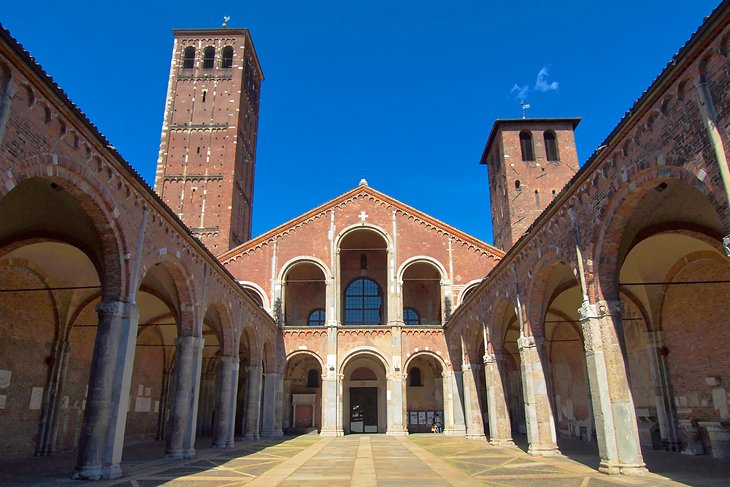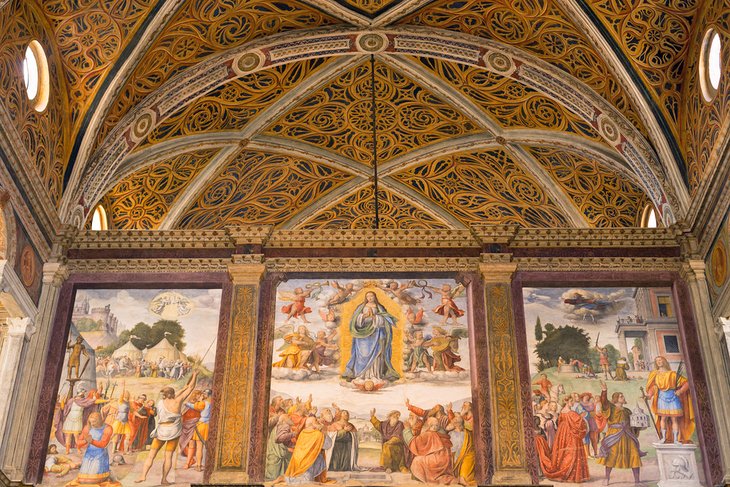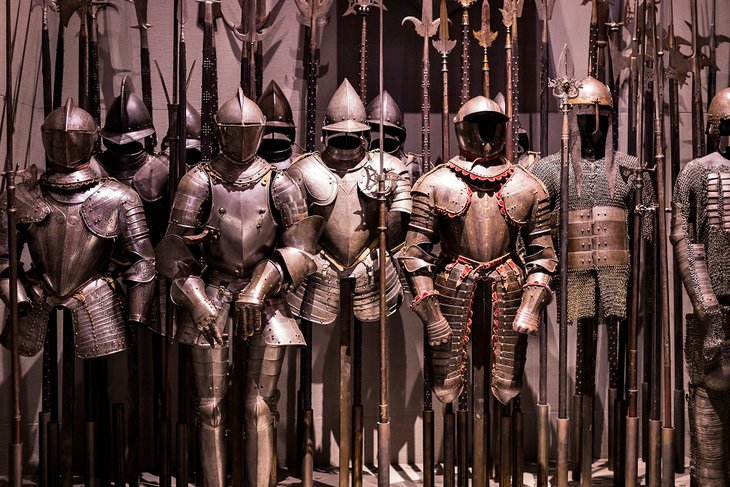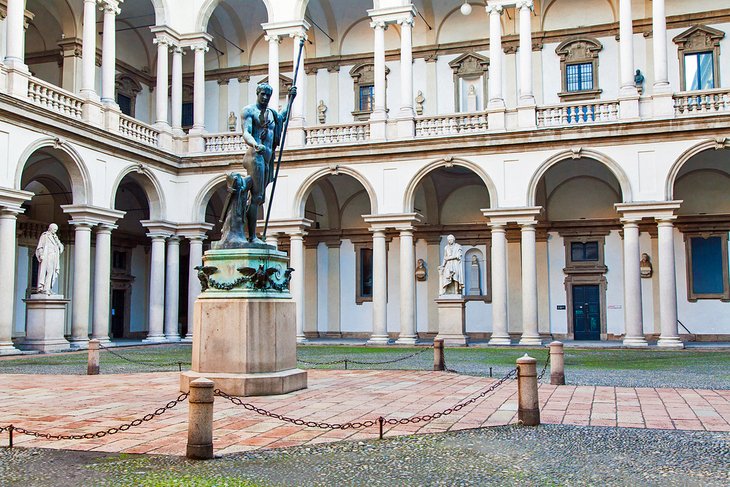Milan, a metropolis in Italy’s northern Lombardy region, is a global capital of fashion and design. Home to the national stock exchange, it’s a financial hub also known for its high-end restaurants and shops. The Gothic Duomo di Milano cathedral and the Santa Maria delle Grazie convent, housing Leonardo da Vinci’s mural “The Last Supper,” testify to centuries of art and culture.
Milan is considered a leading alpha global city, with strengths in the fields of art, chemicals, commerce, design, education, entertainment, fashion, finance, healthcare, media (communication), services, research and tourism. Its business district hosts Italy’s stock exchange (Italian: Borsa Italiana), and the headquarters of national and international banks and companies. In terms of GDP, Milan is the wealthiest city in Italy, has the third-largest economy among EU cities after Paris and Madrid, and is the wealthiest among EU non-capital cities. Milan is viewed along with Turin as the southernmost part of the Blue Banana urban development corridor (also known as the “European Megalopolis”), and one of the Four Motors for Europe.
The city’s role as a major political centre dates back to the late antiquity, when it served as the capital of the Western Roman Empire, while from the 12th century until the 16th century, Milan was one of the largest European cities, and a major trade and commercial centre, consequently becoming the capital of the Duchy of Milan, which was one of the greatest political, artistic and fashion forces in the Renaissance. Despite losing much of its political and cultural importance in the early modern period, the city regained its status as a major economic and political centre, being considered today as the industrial and financial capital of Italy.
1.Leonardo da Vinci’s Last Supper

The Last Supper is a mural painting by the Italian High Renaissance artist Leonardo da Vinci, dated to c. 1495–1498.
The Gothic brick church of Santa Maria delle Grazie, in the Corso Magenta, was begun about 1465, and its massive six-sided dome in the finest Early Renaissance style was designed by Bramante, one of Italy’s most influential Renaissance architects.
The church – and adjoining refectory, which holds Leonardo da Vinci’s Last Supper – were badly damaged in World War II, and during the repair work, old sgraffito paintings in the dome were brought to light. At the end of the north aisle is the Baroque chapel of the Madonna delle Grazie, with an altarpiece of the Madonna.
But the reason most tourists visit Santa Maria delle Grazie is to see da Vinci’s most famous work, painted on the refectory wall of the former Dominican monastery. The Cenacolo Vinciano, as it is called here, was painted on the wall in tempera between 1495 and 1497.
The work was commissioned as part of a plan of renovations to the church and its convent buildings by Leonardo’s patron Ludovico Sforza, Duke of Milan. In order to permit his inconsistent painting schedule and frequent revisions, it is painted with materials that allowed for regular alterations: tempera on gesso, pitch, and mastic. Due to the methods used, a variety of environmental factors, and intentional damage, little of the original painting remains today despite numerous restoration attempts, the last being completed in 1999. Housed in the refectory of the Convent of Santa Maria delle Grazie in Milan, Italy, The Last Supper is his largest work, aside from the Sala delle Asse.
2.Il Duomo (Milan Cathedral)

Milan Cathedral, or Metropolitan Cathedral-Basilica of the Nativity of Saint Mary, is the cathedral church of Milan, Lombardy, Italy. Dedicated to the Nativity of St Mary, it is the seat of the Archbishop of Milan, currently Archbishop Mario Delpini.
The massive Cathedral of Santa Maria Nascente, which the Milanese call just “Il Duomo” is among the world’s largest (it holds up to 40,000 people) and most magnificent churches, the ultimate example of the Flamboyant Gothic style. It was begun in the 14th century, but its façade was not completed until the early 1800s, under Napoleon.
The roof is topped by 135 delicately carved stone pinnacles and the exterior is decorated with 2,245 marble statues. The dim interior, in striking contrast to the brilliant and richly patterned exterior, makes a powerful impression with its 52 gigantic pillars. The stained-glass windows in the nave (mostly 15th-16th centuries) are the largest in the world; the earliest of them are in the south aisle.
The cathedral took nearly six centuries to complete: construction began in 1386, and the final details were completed in 1965. It is the largest church in the Italian Republic—the larger St. Peter’s Basilica is in the State of Vatican City, a sovereign state—and possibly the second largest in Europe and the third largest in the world (its size and position remain a matter of debate).
3.Castello Sforzesco

The Castello Sforzesco is a medieval fortification located in Milan, northern Italy. It was built in the 15th century by Francesco Sforza, Duke of Milan, on the remnants of a 14th-century fortification. Later renovated and enlarged, in the 16th and 17th centuries it was one of the largest citadels in Europe.
The Castello Sforzesco, held by the Visconti and the Sforza families who ruled Milan from 1277 to 1447 and from 1450 to 1535 respectively, was built in 1368 and rebuilt in 1450. The 70-meter Torre de Filarete is a 1905 reproduction of the original gate-tower.
The Castello houses the Musei del Castello Sforzesco, a series of museums, one of which features sculpture. The collection includes the Pietà Rondanini, Michelangelo’s last masterpiece, brought here in 1953 from the Palazzo Rondanini in Rome.
Other museums feature a collection of decorative art, prehistoric and Egyptian antiquities, a collection of musical history, and an armory of weapons and medieval armor.
The Castello Sforzesco (Italian for “Sforza’s Castle”) is a medieval fortification located in Milan, northern Italy. It was built in the 15th century by Francesco Sforza, Duke of Milan, on the remnants of a 14th-century fortification. Later renovated and enlarged, in the 16th and 17th centuries it was one of the largest citadels in Europe. Extensively rebuilt by Luca Beltrami in 1891–1905, it now houses several of the city’s museums and art collections.
4.Pinacoteca di Brera
The Pinacoteca di Brera is the main public gallery for paintings in Milan, Italy. It contains one of the foremost collections of Italian paintings from the 13th to the 20th century, an outgrowth of the cultural program of the Brera Academy, which shares the site in the Palazzo Brera.
The Renaissance Palazzo di Brera, built between 1651 and 1773, was originally a Jesuit college, but since 1776 has been the Accademia di Belle Arti (Academy of Fine Arts). Along with a library and observatory, it contains the Pinacoteca di Brera, one of Italy’s finest art museums.
Much of the art was acquired as churches closed or were demolished, and the museum is especially strong in paintings by northern Italian masters. As you enter through the courtyard, you’ll see an 1809 monument to Napoleon I by the sculptor Canova.
Notable among 15th-century pictures are works by Mantegna (Madonna in a Ring of Angels’ Heads and Lamentation). The Venetian masters are represented by Giovanni Bellini (Lamentation and two Madonnas), Paolo Veronese, Titian (Count Antonio Porcia and St. Jerome), and Tintoretto (Finding of St. Mark’s Body and Descent from the Cross), and portraits by Lorenzo Lotto and Giovanni Battista Moroni.
De galerij is gevestigd in een barok paleis, Palazzo Brera, samen met de oude bibliotheek van Brera (Biblioteca Nazionale Braidense), het Lombardisch Instituut voor Wetenschap en Letteren (Istituto Lombardo Accademia di Scienze e Lettere), de Sterrenwacht en de Botanische Tuin (Osservatorio Astronomico e Giardino Botanico di Brera) en de Academie voor Schone Kunsten (l’Accademia di Belle Arti di Brera).
5.Sant’Ambrogio

Ambrose of Milan, venerated as Saint Ambrose, was a theologian and statesman who served as Bishop of Milan from 374 to 397. He expressed himself prominently as a public figure, fiercely promoting the Christian faith against Arianism and paganism.
The church of Sant’Ambrogio was founded in 386 by St. Ambrose, who was born in Milan and is the city’s patron saint. The present church is a masterpiece of Romanesque architecture, built in the 12th century around the choir from an earlier ninth-century church.
There’s a lot to see here, beginning with the large portico, also from the ninth century, and the atrium, whose carved stone capitals and portal rank it high among Europe’s best examples of the Romanesque period.
Inside, be sure to see the pulpit with late Romanesque carving, and the richly carved 4th-century Stilicone sarcophagus underneath it. The casing (paliotto) of the high altar is a masterpiece of Carolingian art made in 835 at either Milan or Rheims. It’s easy to miss the mosaic dome of the original 4th-century Sacello di San Vittore, accessed through the last chapel on the right.
ne of the most ancient churches in Milan, it was built by St. Ambrose in 379–386, in an area where numerous martyrs of the Roman persecutions had been buried. The first name of the church was in fact Basilica Martyrum.
When St. Ambrose arrived in Milan, the local churches were in conflict with each other over the conflict between Arianism and the Nicene Creed as well as numerous local issues. He was firmly in support of the Nicene side of the conflict and wanted to make northern Italy into a pro-Rome stronghold. He did this through both preaching and construction. He built three or four churches surrounding the city; Basilica Apostolorum (now San Nazaro in Brolo), Basilica Virginum (now San Simpliciano), and Basilica Martyrum (which was later renamed in his honour). A fourth church, Basilica Salvatoris (now San Dionigi), is attributed to him as well, but may not actually be from the 4th century. These churches were dedicated with anti-Arian language and as symbols of the wealth and power of the pro-Nicene faction in Milan.
6.San Maurizio and the Archaeology Museum

The Archaeological Museum of Milan is located in the ex-convent of the Monastero Maggiore, alongside the ancient church of San Maurizio al Monastero Maggiore, with entrance on Corso Magenta.
To many, the interior of the church of San Maurizio is the most beautiful in Milan. Built in the early 1500s as the church for a convent of Benedictine nuns, the entire interior is covered in frescoes of biblical scenes. Not only are these by some of the best Lombard artists of the 16th century – principally Bernardino Luini and his sons – but the colors of the paintings are as vivid as if they’d been painted yesterday. The long nave is divided into two sections, the rear one reserved as the nuns’ choir.
The extensive monastery was built over the ruins of the Roman circus and portions of the Roman walls, all now part of the Civico Museo Archeologico (Archaeology Museum), where you can see these excavated remains of Roman Milan.
Collections of the museum from prehistoric and Egyptian civilisations are housed at the Castello Sforzesco Museums.
Statues and tombs from ancient Rome are displayed along the cloisters of the former monastery, and a path leads from the cloisters to a “polygonal tower (late third century) with early medieval frescoes (thirteenth century) and comes out in the new museum in Via Nirone where the early medieval section is on the first floor.
7.Poldi-Pezzoli Museum

The Museo Poldi Pezzoli is an art museum in Milan, Italy. It is located near the Teatro alla Scala, on Via Manzoni 12. The museum was originated in the 19th century as a private collection of Gian Giacomo Poldi Pezzoli and his mother, Rosa Trivulzio, of the family of the condottiero Gian Giacomo Trivulzio.
Pezzoli in his testament left the house and contents to the Brera Academy. Giuseppe Bertini, director of the Academy, opened the museum on 25 April 1881. During World War II, the palazzo suffered severe damage, but the artworks had been placed in safe storage. The museum was reopened in 1951 after reconstruction.
An elegant old patrician house is the setting for this art museum, which originated in the 19th century as the private collection of Gian Giacomo Poldi Pezzoli and his mother, Rosa Trivulzio. Highlights are paintings by Botticelli, Mantegna, Piero della Francesca, Guardí, and other artists, as well jewelry, silver, bronzes, porcelains, Etruscan pottery, armor, and weapons.
Textiles in the museum include Flemish and Persian carpets, tapestries, a large collection of hand-worked lace, and a very rare embroidery designed by Botticelli.
The museum is notable for its broad collection of Northern Italian and Netherlandish/Flemish artists. The exhibition includes weaponry, glassworks, ceramics, jewelry, and furnishings.










